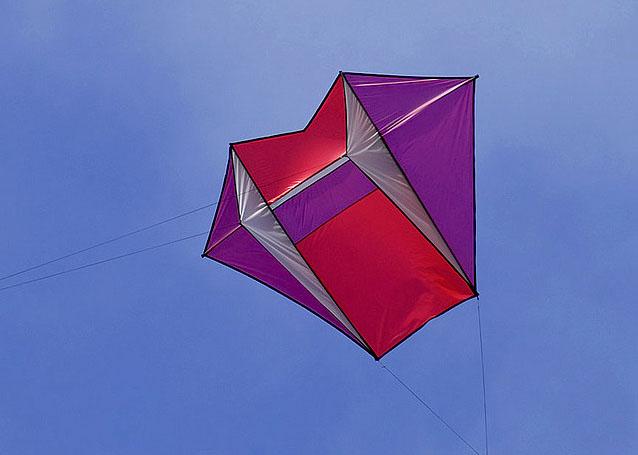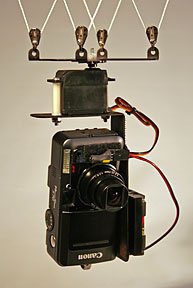Choosing a kite for aerial photography requires some experience. Newcomers are probably best advised to seek guidance from local enthusiasts or relevant websites. Selection inevitably depends upon specific objectives and what equipment has to be lifted. Lifting capacity, wind strength and stability are key considerations.
Kites can be divided, broadly speaking, in to two categories:
- Framed kites - those with some rigid elements; and
- Soft kites - those consisting of fabric only.
Larger rigid-framed kites of up to about 30 - 35 square feet are generally used in light winds (perhaps up to about ten or fifteen miles per hour), and smaller rigid kites for higher wind speeds. Soft kites of various sizes are usually preferred for stronger winds (up to about 25 miles per hour). In very strong winds, controlling a kite may be difficult and even dangerous.
Framed Kites
Framed kites require some degree of setup on site, but the better designs are relatively simple to handle. Some will also fly at a higher angle than soft kites such as parafoils. They are composed of rigid or semi-rigid rods of fibreglass or graphite which hold the fabric covering in the required aerodynamic form. Rigid-framed kites have a somewhat higher ratio of weight to surface area than soft kites but perform better in light airs not least because their form is not dependent upon wind pressure.
Soft Kites
The parafoil, normally a near-square wind-inflated arrangement of aerofoil sections, is an extremely powerful lifter. Indeed it has been used for industrial purposes in various parts of the world for precisely this reason. Once set up correctly, a reasonably large parafoil can prove very stable although the lifting capability and tether load should never be underestimated. A drogue tail can be added for improved stability. Large parafoils, such as those larger than about two metres square (42 square feet), have the potential to lift a person in to the air in a strong winds. They are not toys, need to be tethered to a fixed point, and should be handled only by those with adequate experience. A significant advantage of this type of kite is that is is easily packed and transported.
Kite Line
Larger kites obviously require a heavier line, particularly in high wind speeds. A parafoil having an area of up to 30 - 40 square feet is typically tethered by a 250lb braided dacron line. Black line is generally preferred because it is less apparent in images. Larger parafoils and other large kites may be tethered using 500lb line. Note that kite line can easily cut or burn hands, so leather gloves are essential. A 500 - 700 foot length of line is normally sufficient since kites are usually restricted to a height of 500 feet.
Camera Rig, Levelling and Stabilization
In most cases the camera is attached to the line below the kite rather than the kite itself. This allows the kite to reach a stable flying position before the camera rig is lifted. The angle adopted by the tether varies as the kite rises and falls, so a pendulum mechanism or a Picavet rig is used to achieve a stable horizontal position for the camera.
A pendulum-type suspension system hangs the camera below a rigid bearer and relies upon gravity to maintain a level position. Some camera movement inevitably result from oscillation of the pendulum but the approach is largely successful when a reasonably high shutter speed is used.
The Picavet rig, named after its inventor, consists of a rigid four-point cross of material suspended from a cat's-cradle of lines attached to two points on the kite's tether. A cord is threaded through small pulleys located at each point of the cross in such a way that the platform remains horizontal as the angle of the kite and tether vary. There are many variations on this basic design now available.
Shutter Release
Options for releasing the camera's shutter include model aircraft radio controlled servos, infrared or radio remote controls, wired connections and using the camera's automatic interval timer (which takes pictures at programmed intervals). More sophisticated rigs allow rotation of the camera from a horizontal to a vertical position, either manually or under remote radio control.








